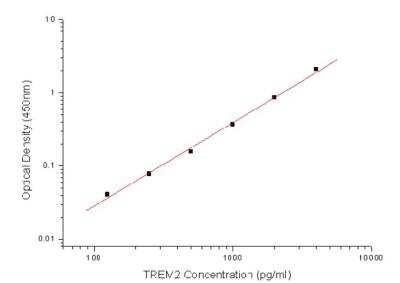TREM2 Antibody Pair [HRP]
Novus Biologicals, part of Bio-Techne | Catalog # NBP2-79344

Key Product Details
Assay Type
Sandwich ELISA
Assay Range
54.69-3500 pg/ml (example only; lot dependent)
Sensitivity
54.69 pg/ml (example only; lot dependent)
Reactivity
Human
Product Specifications
Description
Solid Phase sandwich ELISA for the quantitative determination of Human TREM2.
Sample Volume Required
100 ul
Conjugate
HRP
Scientific Data Images for TREM2 Antibody Pair [HRP]
Sandwich ELISA: TREM2 Antibody Pair [HRP] [NBP2-79344] - This standard curve is only for demonstration purposes. A standard curve should be generated for each assay.
Kit Contents for TREM2 Antibody Pair [HRP]
- Mouse Monoclonal Capture Antibody: (Catalog # NBP2-89791)
- Rabbit Monoclonal Detection Antibody (HRP-conjugated)
- Standard
Preparation and Storage
Shipping
The product is shipped with polar packs. Upon receipt, store it immediately at the temperature recommended below.
Stability & Storage
Storage of components varies. See protocol for specific instructions.
Background: TREM2
TREM2 is upregulated under many pathological conditions and has been of particular interest in neurodegenerative disorders like Alzheimer's disease (AD) where it helps activate microglial responses (1-3,5). Studies have found that sTREM2 is typically elevated in the cerebral spinal fluid (CSF) of AD patients compared to healthy counterparts and may serve as a biomarker of AD (2). While TREM2-mediated microglial activation is considered beneficial in some disease contexts (e.g. demyelinating diseases, ischemia), it is detrimental in others (e.g. peripheral nerve injury) and may be dependent on disease stage, as observed in AD (2,5). Microglia promote amyloid-beta (Abeta) clearance, phagocytosis and reduce tau proliferation in the early stages of AD but can increase Abeta accumulation and tau propagation in late stages of AD (2). Recent studies have also suggested a role for TREM2 in cancer, where it supports an immune-suppressive tumor microenvironment such as reduced of T cell proliferation (1,6). Therapeutic targeting of the TREM2 pathway can be directed towards ligand binding to downstream signaling (1). Potential therapeutic strategies include using monoclonal antibodies or small molecules to either enhance or block signaling (1,6). While more work needs to be done, initial studies targeting TREM2 for cancer immunotherapy is promising (6).
References
1. Deczkowska A, Weiner A, Amit I. The Physiology, Pathology, and Potential Therapeutic Applications of the TREM2 Signaling Pathway. Cell. 2020; 181(6):1207-1217. https://doi.org/10.1016/j.cell.2020.05.003
2. Qin Q, Teng Z, Liu C, Li Q, Yin Y, Tang Y. TREM2, microglia, and Alzheimer's disease. Mech Ageing Dev. 2021; 195:111438. https://doi.org/10.1016/j.mad.2021.111438
3. Kober DL, Brett TJ. TREM2-Ligand Interactions in Health and Disease. J Mol Biol. 2017; 429(11):1607-1629. https://doi.org/10.1016/j.jmb.2017.04.004
4. Uniprot (Q9NZC2)
5. Konishi H, Kiyama H. Microglial TREM2/DAP12 Signaling: A Double-Edged Sword in Neural Diseases. Front Cell Neurosci. 2018; 12:206. https://doi.org/10.3389/fncel.2018.00206
Long Name
Triggering Receptor Expressed on Myeloid Cells 2
Alternate Names
PLOSL2, TREM-2
Gene Symbol
TREM2
Additional TREM2 Products
Product Documents for TREM2 Antibody Pair [HRP]
Product Specific Notices for TREM2 Antibody Pair [HRP]
This product is for research use only and is not approved for use in humans or in clinical diagnosis. Antibody Pairs are guaranteed for 6 months from date of receipt.
